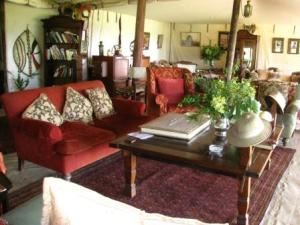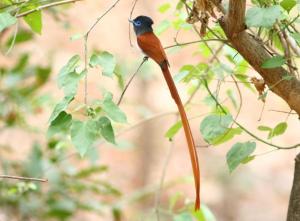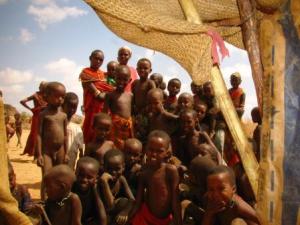Eustace and I departed Rekero Camp after a pleasant breakfast and a tour of the camp by Jackson. The extraordinary amount of game in the region makes Rekero a very special place. In and around this Talek River-fronted camp are hippos, crocodiles and elephants; a leopard was seen in a nearby tree the day we arrived; the wildebeest and zebras are gathering on the banks of the river, waiting for the right moment to cross. The crocodiles lay in wait.
We have two more camps to inspect today, but Eustace clearly does not know the location of our first scheduled visit, Cottar’s 1920’s Safari Camp, a private conservancy on the border of Tanzania. So we wander again, asking directions, talking to Maasai who don’t understand Swahili but point us in random directions. Finally one of the workmen at Cottar’s comes to our rescue and we are led to the camp. Cottar’s is an authentic “Out of Africa” film set – the common areas and each of the beautifully appointed private tents are full of period antiques from four generations of the Cottar family – beautiful pieces from their homes and safari outfitting expeditions. I enjoy a simple lunch with Josh, the manager, and some of the other guests. Though it is hard to leave, we still have one more camp to inspect, and given Eustace’s penchant for getting lost, we move on.
It was only a few meters down the track before our vehicle broke down. Josh arranged for his team to make some quick repairs but the delay meant that our visit to Muthaiga Safari Camp would have to wait for my return in February. We arrive at Sekenani Camp before nightfall and I am the only guest in camp. Sweet-faced Simon pours me an Irish whiskey, another potential remedy to my continued tropical malady, and I linger by the fire with Lkapur. We have many friends from the north in common and we spend the night gossiping and telling stories.
The next day, Lkapur sets about spoiling me. Coffee and then breakfast are brought to my tent. I spend half the day working and half the day sleeping. Camp is quiet. There is usually a boisterous troop of baboons in the forests around this camp but the askari’s tell me that there has been a leopard around for the past few nights. Except for the trumpeting of mating elephants at night, everything is sweetly quiet. Enchanting birds flutter in the branches around my tent including a pair of exotic Paradise Flycatchers.
I have 3 full days to work. I write a new BOMA Operations Manual institutionalizing important changes that we have made to REAP in collaboration with the BOMA Village Mentors. One of our most significant changes will be the reduction in the size of the business groups – from five people to three. We will maintain the same grant amount, but make it a shillings based grant, instead of a dollar based grant. Our recent Impact Assessment Survey of the first 100 REAP businesses confirmed that the business groups had significant savings but it was not enough to put the children of five adults through secondary school. We believe that three adults can achieve the same productivity, profits and savings as business groups of five people. With this change, we hope to see a greater impact, in a shorter period of time, on the individual member’s nutritional intake, household assets and savings for medical care and school fees. We will keep the two grant model – the first grant of 7500 shillings is called a Jump Grant and the 2nd grant of 4000 shillings will be given out after a progress report by the Mentors at three months. We’ve simplified our Jump Grant Applications, Standard of Living Index forms and Progress Reports. We’ve added the global Grameen PPI form (Progress out of Poverty Index), at the suggestion of a good friend, as a tool to measure poverty in our region.
All of this has been a collaborative effort, with staff, community members and Mentors providing valuable input and adjustments. Some questions were deleted from our applications because we deemed it impossible to get reliable, consistent data. In small villages with a very poor population, people are hesitant to share certain information. Even the question of children is problematic, as many times people are reluctant to say how many children they have. This once again underscores the value of a program run by local members of the community. The Mentors know everyone, both in town and in the surrounding villages. Each night of our training sessions in Loiyangalani, I found the Mentors in their huts, studying the forms and the information about our programs. In the morning they would come with valuable ideas and suggestions. I am continually humbled by their sincerity and commitment.
On my last afternoon at Sekenani, I lay on my bed and think about all the things that I could continue to write about. Each of my journeys to northern Kenya is full of exceptional people and places that bring me great joy and sadness – and also great anger. There were times when Kura would place a hand on my arm and say, “Pole, pole, Mama Rungu,” as I see the with disgust at the corruption that holds back the prosperity of a nation. So there are things that I do not write about in order not to jeopardize our work.
What is self-evident to me is that we need to seek support from people and organizations that share our perspective on reducing poverty in Africa. BOMA is part of a small and growing movement that represents a departure from traditional aid programs that build schools and homes, dig wells, provide medical care and give away clothes and books. While well-intentioned, those programs many times set low expectations for poor people. And they do not end poverty.
At BOMA, we have to be committed to high expectations that include a long term goal of “prosperity with dignity” for a group of marginalized people who seek to solve their own problems. And while fighting corruption is not our fight, we also know that in order to seek transformative change we need to expand our programs of economic empowerment and education so that, over the long term, emboldened citizens have the power to fight endemic corruption and demand equal services and infrastructure investments for the region.
These are tenuous goals, and when you are ill and exhausted and a sense of equilibrium eludes you, it is easy to be discouraged. Especially when you have people, both here and in the US, who do not want us to succeed. It reminds me of something Kura once told me when we first started working together: “This heart of yours Mama Rungu, the people, they will break that heart.”
If I have learned one thing after years of working in the development field in Africa it is this: the work is not about us. We can provide the framework and scatter seeds of opportunity but the future of BOMA is in the hands of local people who live in the communities in which we work. It is up to them whether they succeed.



